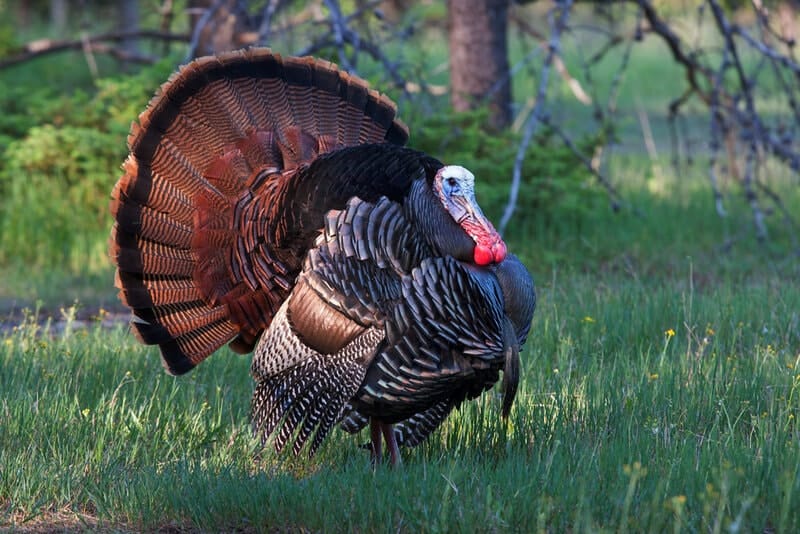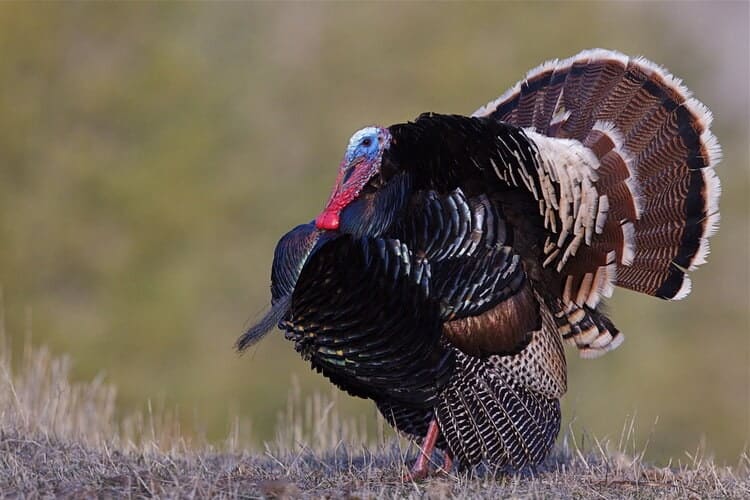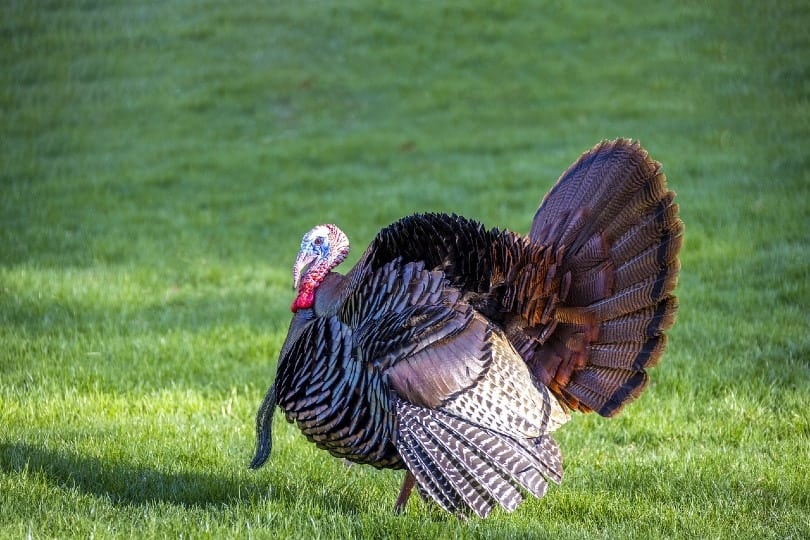For the first half of the twentieth century, the Broad Breasted Bronze Turkey was one of the most popular and recognizable turkey breeds in the United States. Today, it no longer rules the roost. Read on to find out everything you need to know about the Broad Breasted Bronze and how it went from being America’s favorite, to a priority breed for livestock conservation.1
Quick Facts About Broad Breasted Bronze Turkeys

| Breed Name: | Broad Breasted Bronze Turkey |
| Place of Origin: | America |
| Uses: | Meat |
| Weight Male (Young): | 30 lbs |
| Weight Male (Old): | 45 lbs |
| Weight Female (Young): | 18 lbs |
| Weight Female (Old): | 32 lbs |
| Color: | Dark bronze |
| Temperament: | Highly dependent on breeder selection: some are aggressive, others are gentle |
| Status: | Uncommon |
| Weeks to Maturity: | 20 to 24 |
| Wingspan: | Up to 6 feet |
| Length: | Up to 4 feet |
| Egg Color: | Pale cream to medium brown, with spots |
| Egg Size: | Large |
Broad Breasted Bronze Turkey Origins
Bronze turkeys are what happened when domestic turkeys brought from England by colonists, met eastern, wild, American turkeys. Despite evidence that this breed was created in the 18th century, the term “bronze” was not registered until the 1830s, and the American Poultry Association’s Standard of Perfection first admitted the Bronze to its ranks in 1874. During the late 19th and early 20th centuries, enterprising farmers selectively bred Bronzes to achieve a larger-sized bird with a broader breast width. The resulting massive breed of birds became known as the Broad Breasted Bronze. The original Bronze is now called the Standard Bronze. These two turkeys share many similarities and some key differences. The main distinguishing characteristic is the Broad Breasted Bronze’s ability to gain weight, and achieve significant size, rapidly.

Broad Breasted Bronze Turkey Characteristics
The turkey is an American icon, and when you think of the classic Thanksgiving bird, you are probably picturing something quite similar to a Broad Breasted Bronze. The Broad Breasted Bronze is one of the largest, and heaviest, turkey varieties available. This fast-growing, majestic giant of the barnyard must be seen to be believed. It measures up to four feet long and six feet wide. An average full-grown tom will weigh about 40 pounds, and hens can easily reach 30 pounds. This truly is an enormous bird. Its only competition in the size stakes is the breed that replaced it as America’s favorite: the Giant or Broad Breasted White Turkey.
Uses
Broad Breasted Bronze Turkeys are ideal for meat production. Their feed conversion efficiency is very high; meaning they put on weight quickly for the amount of food they consume. As a result of their size, Broad Breasted Bronzes can no longer mate naturally. Today, they are reproduced by artificial insemination only. Following the breed’s development, this bird dominated the commercial turkey industry for twenty years. Known for their flavorful meat, these birds make an excellent Thanksgiving or Christmas dinner. However, eventually, another production turkey, the Broad Breasted White, surpassed the popularity of the Broad Breasted Bronze Turkey. This is because the pinfeathers of the Broad Breasted Bronze are dark. These dark pinfeathers remain more visible in the dressed bird than the white pinfeathers of the Broad Breasted White. The Broad Breasted White’s cleaner-looking carcass makes for a more attractive option visually, and the Broad Breasted Bronze dropped out of popularity with consumers.
Appearance & Varieties
The Broad Breasted Bronze has a lavish display of plumage, with richly colored feathers, which are very similar to a wild turkey’s. Copper, bronze, and gold are present in its coloration. Under direct sunlight, its metallic brown colors are further enhanced by an iridescent blue-green sheen. Chicks and poults are dark brown, with distinctive stripes.
As we’ve already seen, the current Broad Breasted Bronze is considerably larger than the ancestor from which it was selectively bred. In addition to the breast being wider, it also protrudes in front. This bulge is partly responsible for preventing natural mating. Aside from this dramatic size difference, the Broad Breasted’s plumage is usually darker and slightly more matte than that of the Standard’s, although it would be difficult to spot this subtle shading unless the two breeds were side-by-side. The Broad Breasted’s legs also tend to be shorter than the Standard’s.

Population & Habitat
The once-dominant Broad Breasted Bronze has seen its numbers dwindle away, to the point that the American Livestock Breed Conservancy has added the Broad Breasted Bronze to its conservation priority list. Almost all of the more than 280 million turkeys that are produced in the United States and Canada each year for the holidays are raised on industrial farms. Among this total, 99 percent of turkeys raised and slaughtered are Broad Breasted White turkeys. All other breeds of turkey make up the remaining one percent of turkeys reared.
If you do find Broad Breasted Bronze poults for sale, when you get yours home, you will discover that like other turkeys, it is an active scavenger. Ideally, you should provide a minimum of five to six square feet per bird. Your turkey will walk laps of its space each day, searching out insects and plants to eat. The Broad Breasted Bronze will take to roosting in your trees, if given the opportunity when it is very young. However, as it gains weight quickly, it won’t take long for the practice to become unsustainable for this mammoth creature.

Are Broad Breasted Bronze Turkeys Good for Small-Scale Farming?

As a result of the dominance of the Broad Breasted White, you may find it difficult to find Broad Breasted Bronze hatchlings on the market. Should you wish to breed Broad Breasted Bronzes yourself, you will need to master artificial poultry insemination. Despite the difficulties associated with sourcing and reproducing them, the Broad Breasted Bronze has retained some popularity with backyard and barnyard producers.
Keep in mind that modern Broad Breasted Bronzes were designed for large-scale confinement production on industrial-type farms. This breed’s ability to pack on the pounds means that Broad Breasted Bronze turkeys are generally butchered at five to six months old. Most farmers agree that this is not a bird that you can keep year-round: it should be raised with a calendar date in mind. Most birds will experience a significant diminishment in quality of life beyond this point. As they go up in weight beyond 40 lbs, their great girth and weight can trigger issues such as heart failure, or foot and leg deformity. That being said, this is still a great breed for seasonally-based, small-scale farming.
Conclusion
Over the past century, the popularity of this breed has experienced dramatic shifts. Currently, conservation efforts are needed to protect the Broad Breasted Bronze Turkey. Breeding flocks are only maintained by a few hatcheries, and many of them are reducing their numbers. If you want to keep a flock of turkeys over multiple years, hatching their eggs and raising poults, consider choosing a different variety of turkey. If you have a particular occasion or season in mind, then this majestic and handsome bird is ideally suited for quickly fattening up over its short and productive life.
Featured Image Credit: Bruce MacQueen, Shutterstock

